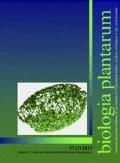Abstract
Various ecophysiological investigations are presented in Aldrovanda vesiculosa, a rootless aquatic carnivorous plant. A distinct polarity of N, P, and Ca tissue content per dry mass (DM) unit was found along Aldrovanda shoots. Due to effective re-utilization, relatively small proportions of N (10 – 13 %) and P (33 – 43 %) are probably lost with senescent leaf whorls, while there is complete loss of all Ca, K, and Mg. The total content of starch and free sugars was 26 – 47 % DM along adult shoots, with the maximum in the 7th – 10th whorls. About 30 % of the total maximum sugar content was probably lost with dead whorls. The plant was found to take up 5 – 7 times more NH4 + to NO3 − from a mineral medium. Under nearly-natural conditions in an outdoor cultivation container, catching of prey led to significantly more rapid growth than in unfed plants. DM of the fed controls was 48 % higher than in the unfed plants. The controls produced 0.69 branches per plant, while the unfed plants did not produced any. However, the N and P content per DM unit increased by 6 – 25 % in the apices and the first 6 whorls in the unfed variant, as compared to the fed controls. It may be suggested that carnivory is very important for Aldrovanda.
Similar content being viewed by others
References
Adamec, L.: Ecological requirements and recent European distribution of the aquatic carnivorous plant Aldrovanda vesiculosa L. —A review.-Folia geobot. phytotax. 30: 53–61, 1995a.
Adamec, L.: Ecophysiological study of the aquatic carnivorous plant Aldrovanda vesiculosa L.-Acta bot. gall. 142: 681–684, 1995b.
Adamec, L.: Photosynthetic characteristics of the aquatic carnivorous plant Aldrovanda vesiculosa.-Aquat. Bot. 59: 297–306, 1997a.
Adamec, L.: How to grow Aldrovanda vesiculosa outdoors.-Carniv. Plant Newslett. 26: 85–88, 1997b.
Adamec, L.: Mineral nutrition of carnivorous plants: A review.-Bot. Rev. 63: 273–299, 1997c.
Adamec, L.: Seasonal growth dynamics and overwintering of the aquatic carnivorous plant Aldrovanda vesiculosa at experimental field sites.-Folia geobot. 34: 287–297, 1999.
číŽková, H., Lukavská, J., Přibáň, K., Kopecký, J., Brabcová, H.: Carbohydrate levels in rhizomes of Phragmites australis at an oligotrophic and a eutrophic site: A preliminary study.-Folia geobot. phytotax. 31: 111–118, 1996.
Fabian-Galan, G., Salageanu, N.: Considerations on the nutrition of certain carnivorous plants (Drosera capensis and Aldrovanda vesiculosa).-Rev. roum. Biol. Sér. Bot. 13: 275–280, 1968.
Friday, L.E.: Rapid turnover of traps in Utricularia vulgaris L.-Oecologia 80: 272–277, 1989.
Friday, L.E., Quarmby, C.: Uptake and translocation of prey-derived 15N and 32P in Utricularia vulgaris L.-New Phytol. 126: 273–281, 1994.
Kamiński, R.: Studies on the ecology of Aldrovanda vesiculosa L. I. Ecological differentiation of A. vesiculosa population under the influence of chemical factors in the habitat.-Ekol. pol. 35: 559–590, 1987a.
Kamiński, R.: Studies on the ecology of Aldrovanda vesiculosa L. II. Organic substances, physical and biotic factors and the growth and development of A. vesiculosa.-Ekol. pol. 35: 591–609, 1987b.
Kamiński R., Adamec L., Breckpot C.: Report on recent sites of Aldrovanda vesiculosa (Droseraceae) in Poland.-Fragm. flor. Geobot. 41: 291–294, 1996.
Lloyd, F.E.: The Carnivorous Plants. (Chronica Botanica Vol. 9).-Waltham 1942.
Mazrimas, J.A.: Aldrovanda.-Carniv. Plant Newslett. 7: 102–103, 1978.
Moeller, R.E.: The temperature-determined growing season of a submerged hydrophyte: tissue chemistry and biomass turnover of Utricularia purpurea.-Freshwater Biol. 10: 391–400, 1980.
Pechar, L.: Use of the acetone-methanol mixture for extraction and spectrophotometric determination of chlorophyll a in phytoplankton.-Arch. Hydrobiol. 78(Suppl): 99–117, 1987.
Schuurkes, J.A.A.R., Kok, C.J., Den Hartog, C.: Ammonium and nitrate uptake by aquatic plants from poorly buffered and acidified waters.-Aquat. Bot. 24: 131–146, 1986.
Winston, R.D., Gorham, P.R.: Turions and dormancy states in Utricularia vulgaris.-Can. J. Bot. 57: 2740–2749, 1979.
Author information
Authors and Affiliations
Rights and permissions
About this article
Cite this article
Adamec, L. Rootless Aquatic Plant Aldrovanda Vesiculosa: Physiological Polarity, Mineral Nutrition, and Importance of Carnivory. Biologia Plantarum 43, 113–119 (2000). https://doi.org/10.1023/A:1026567300241
Issue Date:
DOI: https://doi.org/10.1023/A:1026567300241




